In July the Group held its second event of the year with a visit to Kent. First visiting Canterbury Cathedral and then Edward Vinson's soft fruit breeding programme. A summary of the event appears below.
On Friday 19 September we will be holding our Annual General Meeting at our newly refurbished building in Belgrave Square. Immediately after the AGM we will have presentations from this year's David Miller Award winners as well as updates from last year's winner. All Members of the Group are welcome.
In the same week we will be joining the Professional Horticulture Group South West for a visit to 'Desert and Jungle' and 'Top Plants', two contrasting Somerset nurseries.
Peter Grimbly
Contents
Old Foundations and New Fruits
Plant of the Month
News from our Associates
Horticulture Industry News
Events Calendar
Horticulture Group contact details
Related Links
Old Foundations and New Fruits
In July, Tony Girard organised a morning tour of the Deanery Gardens at Canterbury Catherdral followed by a visit to the soft fruit breeding programme of Edward Vinson.
Canterbury Cathedral and its original monastic surroundings have been built, rebuilt, remodelled and modified for over 14 centuries since St Augustine first founded it in the early part of the 7th century. While the Deanery is by comparison a younger building it has had its fair share of remodelling not least as the result of a World War II bomb. The result today is a wonderful patchwork of stone, brickwork and flint that provides a beautiful backdrop to the secluded gardens beyond.
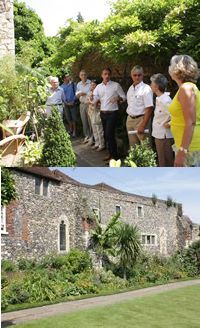
After an introduction to the history of the building and its immediate surroundings in the remnants of the original monastery we proceeded into an enclosed courtyard (upper picture) where an interesting range of plants was benefitting from the protection afforded by the walls. Even the door we entered by was a recent modification added because the original narrow doorway, while adequate for mediaeval monks was proving a challenge for the Dean's more corpulent modern visitors.
The main garden beyond surrounds a large lawn essential for entertaining the Dean’s many guests. In the centre is a magnificent old mulberry tree certainly large enough to have been part of James l ill-founded campaign to encourage an English silk industry.
The high walls of the Deanery itself provide the backdrop for a magnificent herbaceous border (lower picture) including what might be some of the tallest bananas growing in the UK. The other sides of the main lawn are surrounded by a vegetable garden, an orchard and a wild garden. A smaller walled garden to the side, which has been recently acquired, is currently a wildfower meadow dominated at the time of our visit by a particularly vigorous display of wild carrot.
For many centuries the cathedral precincts, including the Deanery, enjoyed their own water supply from springs in the surrounding hills fed to the building by an old lead pipe system. The availablity of this pure water enabled the monks to survive the ravages of the black death and no doubt cholera as well. It was superseded by a modern supply and the old pipework has since been cut by the inevitable utility trench. However, with water becoming an ever more scarce resource they are considering repairing the missing section to provide a supply to the Deanery gardens.
Edward Vinson
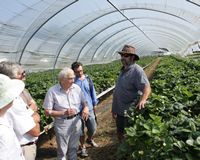
They started with strawberry breeding in 1985 in parallel with the programme at East Malling. At the time there were good varieties being produced in California for the American market but these did not adapt well to UK conditions so there was a need for home grown varieties.
Like any breeding programme they begin with a selected range of crosses to produce seedlings for the following year. Starting with some 36,000 seedlings these are whittled down to around a dozen that survive the selection criteria for shape, firmness, uniformity, texture, taste etc. These then go on to field trials in the UK and Spain and the best finally to growers. As new selection can only be propagated vegetatively they are licensed to propagators around the world. Sadly the fruit of all those that fail the selection process is unmarketable as they are unregistered. Our group thus left well filled with some very tasty strawberries.
Strawberries have seven chromosomes which should in theory make breeding relatively simple. However, strawberry species vary from the standard diploid (14 chromosomes) to decaploid (70 chromosomes) and even more. The majority of cultivars are octoploid (56 chromosomes). Thus while species such as the common wild strawberry (Fragaria vesca) with 14 chromosomes might have useful characters the results of crossing will be highly unstable if they are viable at all.
They have since started similar programmes for raspberry, blackcurrant and blueberry. At the time of our visit there were only first year seedlings of blueberries being grown however there were some impressive blackberries with tasty fruit of enormous size.
Peter Grimbly
Plant of the Month
Magnolia campbellii subsp. mollicomata, Magnoliaceae
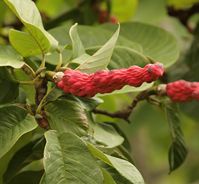
This particular subspecies occurs in the eastern area of the overall distribution – in northern Burma (Myanmar) and southwest China, including southeastern Tibet. The distinguishing features of the subspecies? It has a silky, hairy flower stalk whereas the straight species has a smooth and hairless stalk. There are also reportedly minor differences in bud shape, apparent when the bud scales first fall off in spring.
On first seeing this subspecies in 1904 on the western side of the Mekong Valley in Yunnan, George Forrest is reported to have said 'I shall always remember my first sight of a group of these magnificent Magnolias in full flower! I got within a mile of them, from which distance the masses of pink blossoms showed up distinctly, but surrounded, as the trees were, by heavy snowdrifts ten to twelve feet in depth, fully a week passed before I could secure specimens, by which time the flowers were almost gone.'
It was not until 1914 that this plant appeared in cultivation, but the majority of the older trees growing in the UK originate from seed collected by George Forrest’s 1924 and later expeditions.
This plant loves to grow in deep rich acid soils and is intolerant of drying winds and pollution sensitive, so not good as a street tree. However, this subspecies has the massive benefit of flowering at a much younger age than the parent species – as young as 10 years old. What more could you want? Beautiful buds, stunning flowers and visually arresting fruits.
Alison Foster
Oxford Botanic Garden
Medicinal Plant of the Month
Ricinus communis L. (Euphorbiaceae), Castor oil plant
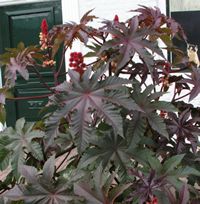
The castor oil plant is one of the few major crops to have an origin in Africa. It has been cultivated for at least 6,000 years; the Egyptians found its seed oil useful in lamps. It is still the seed oil for which this plant is grown commercially today. The seeds, which are about the size of the nail on your little finger, are shiny and dark brown, often with exquisite marbled markings on them (picture lower right by H Zell). They resemble ticks, for which the plant gets its botanical name, Ricinus, whilst the species name means ‘common’. The seeds contain valuable oil and a killer protein.
The killer protein is ricin, and a pellet of this substance was the ‘bullet’ that killed Georgi Markov, a Bulgarian political dissident, living and working in London in 1978. A miniscule pellet containing ricin was fired into his leg from an umbrella, whilst he was waiting for a bus on his way to work. Ricin is one of the most toxic substances known to man, less than one milligram is needed to kill an adult person. Thankfully, the process of extracting castor oil from the seeds ‘denatures’ the protein, i.e., its complex three-dimensional structure is unravelled, rendering it harmless.
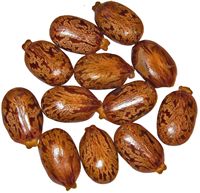
Emsley J 2008. Molecules of murder: criminal molecules and classic cases. RSC Publishing.
Alison Foster
Oxford Botanic Garden
News from our Associates

The annual Naivasha Horticultural Fair will be held on Friday 19 and Saturday 20 September 2014 at the Naivasha Sports Club, Kenya. This highly important event is considered the biggest and most diverse horticultural fair for Kenya and the whole East African region. Following a successful first-time participation in 2010, CHA is planning to organise the first ever dedicated British Pavilion in 2014. Working alongside the British High Commission in Nairobi and with support from UKTI, they also have plans for an extended programme of activities, details of which will be announced shortly.
Following the Naivasha event, CHA will begin recruiting for Growtech Eurasia held in Antalya, Turkey between 3-6 December 2014. For further information on both shows contact CHA.

HIP continues to persue its plan to bid for one of the Centres for Agricultural Innovation that will be funded under the Government’s Agri-Tech Strategy. Details of ths strategy has now been published and Members of the HIP Innovation Centre Executive Steering Group will be attending a briefing event in London on 4th September to glean further information.
HIP has issued a press release which outlines much of the recent activity in driving forward this bid.

The Society responded to the Department for Business Innovation and Skills consultation on Science and Innovation strategy. The response includes a call for an inclusive strategy across government departments and criticises the government for saying ‘Our philosophy is simple: trust people to make their own decisions and they will usually make better ones' and then dictating how money is allocated.
Horticulture Industry News
For the very latest horticultural news follow us on Facebook,
Twitter, or
LinkedIn
The global invasion of crop pests
Many of the world's most important crop-producing countries will be fully saturated with pests by the middle of the century if current trends continue, according to a new study. More than one-in-ten pest types can already be found in around half the countries that grow their host crops. If this spread advances at its current rate, scientists fear that a significant proportion of global crop-producing countries will be overwhelmed by pests within the next 30 years. The study identifies the pests likely to be the most invasive in coming years, including: three species of tropical root knot nematode whose larvae infect the roots of thousands of different plant species; Blumeria graminis, a fungus that causes powdery mildew on wheat and other cereals; and the Citrus tristeza virus (given its name meaning 'sadness' in Portuguese and Spanish by farmers in the 1930s) which had reached 105 of 145 countries growing citrus by 2000. Fungi lead the worldwide invasion of crops and are the most widely dispersed group, despite having the narrowest range of hosts. The study looked at the current distributions of 1,901 crop pests and pathogens and historical observations of a further 424 species. Significant use was made of historical CABI records, which document crop pests and diseases around the world from 1822 to the present day. More
Modified yeast to replace poppies
Genetically engineered yeasts can now efficiently produce a range of opiates, including morphine and oxycodone. Opiates are primarily used as painkillers and cough suppressants, and many of the most widely used opiates can be produced only from opium poppies (Papaver somniferum). Demand for these drugs is booming. But of the poppies farmed to supply these drugs, some 50 per cent are grown on the Australian island of Tasmania, so poor growing seasons can affect availability. As drug companies search for new places to grow poppies, scientists have been looking at getting yeast to make these complex drugs from simple sugars. Back in 2008, they inserted a number of genes – including some from the opium poppy – into yeasts, and got them to turn simple sugar molecules into a complex precursor of opiates: salutaridine. Now they have solved the other end of the pathway, engineering yeasts to take complex precursors like thebaine and synthesise the finished products, including oxycodone. More
Earth could be more productive than previously thought
A new analysis suggests the planet can produce much more land-plant biomass than previously thought.
The study recalculates the theoretical limit of terrestrial plant productivity, and finds that it is much higher than many current estimates allow. Most previous research assumes that the maximum productivity you could get out of a landscape is what the natural ecosystem would have produced. But it turns out that in nature very few plants have evolved to maximize their growth rates. Estimates derived from satellite images of vegetation and modeling suggest that about 54 gigatons of carbon is converted into terrestrial plant biomass each year. This value has remained stable for the past several decades, leading to the conclusion that it represents a planetary boundary -- an upper limit on global biomass production. But these assumptions don't take into consideration human efforts to boost plant productivity through genetic manipulation, plant breeding and land management. Such efforts have already yielded some extremely productive plants. The team used a model of light-use efficiency and the theoretical maximum efficiency with which plant canopies convert solar radiation to biomass to estimate the theoretical limit of net primary production (NPP) on a global scale. This newly calculated limit was roughly two orders of magnitude higher than the productivity of most current managed or natural ecosystems. More
Rust fungus to control Himalayan balsam
A rust fungus has been released at locations in Berkshire, Cornwall and Middlesex as part of field trials to control the non-native, invasive weed Himalayan balsam (Impatiens glandulifera) using natural means. Himalayan balsam has rapidly become one of the UK’s most widespread invasive weeds. The Environment Agency estimates that the weed occupies over 13% of river banks in England and Wales. Using existing measures, the Environment Agency estimates it would cost up to £300 million to eradicate Himalayan balsam from the UK. The release of the rust fungus comes after an eight-year research programme. During the course of the research, testing in quarantine laboratories has established that the rust fungus causes significant damage to Himalayan balsam and does not impact on native species.
Tobacco helps cure Ebola
With the seemingly miraculous recovery of two American missionaries infected with the Ebola virus while treating patients in Liberia, ZMapp, the experimental drug that appears to have cured Dr. Kent Brantly and Nancy Writebol of the deadly disease, has rushed to the spotlight. Aside from the highly unusual fact that it had been tested only on monkeys, ZMapp has another distinction that has drawn attention: It has been engineered into tobacco leaves in a process called biopharming. Most FDA-approved drugs that involve antibodies, vaccines and other proteins are produced in animal cells farmed in expensive bioreactors. But starting in the 1980s, scientists discovered they could also engineer proteins in plant cells. As was the case with ZMapp, many companies settled on the tobacco plant as the ideal host for bioengineered proteins because it grows so quickly and produces a high yield. More
Maths trumps Malthus
Mathematical models are being developed by researchers to identify genes that could improve the resilience of food crops to climate change. With the impacts of climate change such as drought, pest and disease threatening harvests, the mathematical models are hoped to identify traits which could allow for growth of climate-proof crops. Heat-related issues have become more prevalent and dry areas now account for 40% of land cover. A recent workshop in Morocco brought together leading mathematicians and crop scientists to discuss methods of applied mathematics that could speed up the search for agricultural genes for climate change resistant traits. In order to meet the food security needs in the future, experts express this development as critical.
Raising food prices to end hunger
The doctrine that food prices should be kept as low as possible to end hunger is wrong. In practice, policies that keep consumer food prices low, especially when combined with further downward pressure on prices from supermarkets as they compete for customers, may raise the incidence of hunger and malnutrition in the medium- to long-term. This is mainly because over 70% of the 842 million people now suffering from chronic hunger live in rural areas. Food production is usually the dominant economic activity. Two factors determine the health of such rural economies – the volume of farm output and the farm-gate prices of the main products. Even if production remains steady, falling prices have a disastrous effect, putting downward pressure on wages, cutting employment opportunities and discouraging new investment on farms and in rural infrastructure and services.
A Battery Made Of Hemp?
Researchers have developed a super-strong, super-fast, hemp-based battery called a supercapacitor that could charge things like electric cars and power tools and is a cheaper alternative to conventional graphene supercapacitors. To create a hemp supercapacitor, researchers essentially cooked hemp bark in a device similar to a pressure cooker then dissolved some of the plant material that remained. They used industrial hemp, a low-grade version of the cannabis plant that contains only trace amounts of the psychoactive ingredient THC. Hemp grows fast, causes less erosion than other crop plants and requires little to no pesticides during cultivation. Proponents of manufacturing hemp products say the plant has tremendous economic potential.
Events Calendar
Other Events of Interest
Emerging Challenges and Opportunities in Soil Microbiology
1 Sep 2014, Loughborough University
Loughborough, UK
Four Oaks Trade Show
2 - 3 Sep 2014
Lower Withington, UK
Potato Europe
2 - 4 Sep 2014, DLG Service
Hannover, Germany
Vertical Farming and Urban Agriculture
9 - 10 Sep 2014, Centre for Urban Agriculture
Nottinham, UK
Biofumigation
9 - 12 Sep 2014, Association of Applied Biologists
Newport, UK
Plant Nutrition
10 - 12 Sep 2014, German Society of Plant Nutrition
Halle, Germany
Healthy Trees, Healthy People
14 - 17 Sep 2014, Arboriculture Association
Egham, UK
Science & Technology: Innovation on the Horizon
16 Sep 2014
London, UK
Carrot and Other Apiaceae
17 - 19 Sep 2014, International Society for Horticultural Science
Angers, France
Kiwifruit
18 - 22 Sep 2014, International Society for Horticultural Science
Dujiangyan City, China
Naivasha Horticultural Fair (see CHA for exhibitor grants)
19 - 20 Sep 2014
Naivasha, Kenya
Vegetables and Potatoes
29 Sep - 2 Oct 2014, International Society for Horticultural Science
Zagreb, Croatia
BCPC Congress
30 Sep - 1 Oct 2014, British Crop Production Council
Brighton, UK
South West Grow Show
1 Oct 2014
Exeter, UK
National Fruit Show
15 - 16 Oct 2014
Detling, UK
Grapevine Roots
16 - 17 Oct 2014, International Society for Horticultural Science
Rauscedo, Italy
Biocontrol Industry Meeting
20 - 22 Oct 2014
Basel, Switzerland
Implementing the UK Agricultural Technologies Strategy
23 Oct 2014, Westminster Food & Nutrition Form
London, UK
Global Plant Health
27 - 28 Oct 2014, Fera
York, UK
Developments in hand-held application techniques
28 - 29 Oct 2014, Association of Applied Biologists
Barcelona, Spain
BCPC Weeds Review 2014
13 Nov 2014, BCPC
Harpenden, UK
Advances in IPM
19 - 20 Nov 2014, Association of Applied Biologists
Marston, UK
Croptec
19 - 20 Nov 2014
Peterborough, UK
Crop Production in Southern Britain: Precision Decisions for Profitable Cropping
25 - 26 Nov 2014, Association of Applied Biologists
Peterborough, UK
If you would like to advertise a forthcoming event please contact. ester.monfort@soci.org
Horticulture Group Contact Details
For submitting ideas or to volunteer to be part of a committee or a group, please contact:
Chairman - Peter Grimbly
Meetings Secretary - Alison Foster
Minutes Secretary - Margaret Waddy
Newsletter co-ordinator - Sue Grimbly scihortigroup@btinternet.com
Group Contact - Ester Monfort Martinez, E: ester.monfort@soci.org T: +44(0)20 7598 1584
